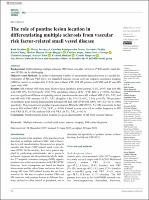The role of pontine lesion location in differentiating multiple sclerosis from vascular risk factor-related small vessel disease

Ver
Autor
Fecha
2021-05Enlace permanente
https://hdl.handle.net/11351/6799DOI
10.1177/1352458520943777
ISSN
1352-4585
WOS
000556869200001
PMID
32757905
Palabras clave
Esclerosis múltiple; Diagnóstico diferencial; ImagenCitación recomendada
Geraldes R, Juryńczyk M, Rodrigues dos Passos G, Pichler A, Chung K, Hagens M, et al. The role of pontine lesion location in differentiating multiple sclerosis from vascular risk factor-related small vessel disease. Mult Scler J. 2021 May;27(6):968–72.
Audiencia
Professionals
Este elemento aparece en las siguientes colecciones
- CEMCAT - Articles científics [161]
- HVH - Articles científics [4471]
El ítem tiene asociados los siguientes ficheros de licencia:

 Área privada
Área privada Contacto
Contacto







